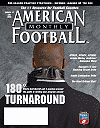AMERICAN FOOTBALL MONTHLY THE #1 RESOURCE FOR FOOTBALL COACHES
Article CategoriesAFM Magazine
|
Inside Linebackers: Drills and Assetsby: Lew Acquarulo© More from this issue At Trinity we run a 3-4 defense with a 4-3 mentality. Our defensive line attacks offenses as opposed to staying on the line of scrimmage and keeping blockers off of our inside linebackers. With this philosophy come some obstacles for our inside linebackers. We begin our first inside linebacker meeting each year stressing the use of our ASSETS. If we are aware of and we master our ASSETS, then we will develop and improve our game dramatically. Our ASSETS help us to diagnose situations and gain advantages over our counterparts. They also help us to complete our assignment. Ours ASSETS are : Eyes – See what is happening in front of you. Hands – Keep offensive personnel away from you. Feet – Stay on your feet; be an athlete. Ears – Listen and hear all cal....The full article can only be seen by subscribers. Subscribe today!
|
|
|||||||
| HOME |
MAGAZINE |
SUBSCRIBE | ONLINE COLUMNISTS | COACHING VIDEOS |
Copyright 2026, AmericanFootballMonthly.com
All Rights Reserved





